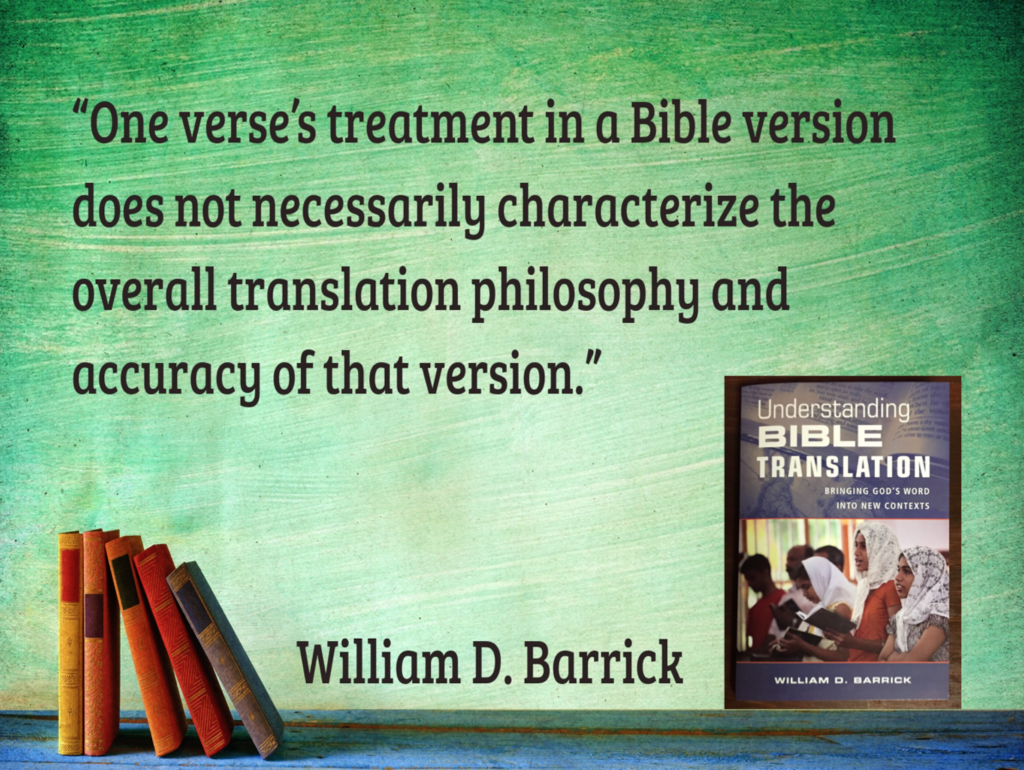
“Barrick’s primary motivation for producing this most excellent work is succinctly summarized on page 31 of Understanding Bible Translation:
The challenge of Bible translation, therefore, is to make the Word of God understandable. It is one of the greatest challenges to which the Christian exegete or expositor might respond. Understanding is the goal of all proclamation of scripture (see Matt. 13:13-15, 19, 23).
For fifty years the author’s reputation for biblical precision has been incontestably established. The scholarly footing and foundation of his current offering is another testimony to this reality. Nevertheless, when it comes to the translation of God’s Word into the vernacular of hundreds and thousands of post-Babel languages and dialects, a Spirit-enabled nuancing is also a prerequisite for perspicuous renderings into those receptor tongues. Providentially the Lord opened up for Dr. Barrick such a door in Bangladesh so that he might attain this crucial balance.
Such a synopsis of the author’s biographical background, as exceedingly brief as it is, helps to understand the value of his latest publication. It is quite unique in that it does not simply hold out to the reader another product of some particular linguistic philosophy or translational theory. It however is born from the seed of exegetical inductivity and comes out of the womb of receptive clarity. For just one example of this balance on page 66 the author declares,
No distinction should exist between accuracy and faithfulness in translation.
Operationally this requires that:
All translations need to be checked against the Hebrew Old Testament and Greek New Testament texts. To do this, the missionary translator needs to be capable in Hebrew, Aramaic, and Greek as well as the receptor languages. Ideally, of course, national translators should be trained in the biblical languages so that they can do the checking. The catch to this is that nationals often need to be taught the biblical languages through the medium of their own language. This might offer an even greater challenge for the missionary translator. Either way, it behooves missionary translators to be reasonably fluent in both the receptor language and biblical languages. (pp. 138–39)
This book is full of sound advice on both how to do and how to evaluate translations. Furthermore, it is documented by concrete examples of passages throughout. Concerning the second arena of evaluation critics fall into one of two generally opposite camps, those guided by a literary (i.e. readability) canon and those driven by a literal standard. Therefore, Barrick has constructed a more balanced grading system by which to evaluate English versions. He implements it by using two passages, one from the OT and one from the NT, to initially evaluate nine English versions. The reader will find this chapter very helpful, but will be led to the inevitable conclusion that ‘no Bible translation is perfect’ (p. 191; cf. top of p. 217).
Chapter 9, ‘What Does It Take To Be A Bible Translator?’ could well be subtitled ‘Counting the Cost’! It too brims with the needed balance between a commitment to hard study and a passion for the needs of people. As demanding as this grand task is, Barrick’s final words seem to be designed to set the stage for an ‘altar call’:
Perhaps God desires for you to be the one to prepare and go. Bible translation is a gospel-proclaiming, church-planting, church-guiding, and Christ-glorifying work. Without it you would not have come to Christ for salvation. Without it you would have no church to attend, no preaching to hear, and no service to perform. (p. 221)
Such a task is obviously foundationaland so is this book for a better understanding of it.” – George Zemek (Th.D., Grace Theological Seminary, Winona Lake, IN), Academic Dean, The Expositors Seminary, Jupiter, FL
